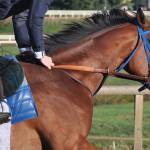Conditioning Programs Create Physiological Effects in Horses

Horses pointed toward performance careers are usually put into a training program that begins with short sessions of easy work and progresses gradually to longer and harder exercise over a period of time until the horse reaches the desired level of fitness. Reaching that goal with a horse that is completely untrained at the beginning of the program will take much longer than slightly increasing fitness in a horse that is already in athletic condition. Even this effort, such as getting a novice-level event horse ready to compete at a more advanced level, should take a number of months. The extended time period is necessary to allow the horse’s musculoskeletal and circulatory systems to adapt to the demands of more intense exercise.
Muscle tissue reacts to increased exercise in several ways. Individual muscle fibers tend to become larger as they are asked to work harder and for longer periods. Training induces a delay in the production of lactate and also influences the fibers to adapt toward using more free fatty acids rather than glycogen. These adaptations slow the onset of fatigue.
Muscle fibers are of two basic types: those that contract quickly for powerful, explosive movements such as sprinting and jumping, and others that contact less intensely to support slower, longer-duration exercise such as endurance racing. Every horse has both types of fibers, though the proportions may vary from horse to horse and breed to breed. There is some evidence that muscles respond to training in a particular kind of exercise by sequentially changing the fiber types to support the demands of that regimen.
Blood supply to the muscles improves as the capillary density increases. The numerous small blood vessels allow a better supply of glucose and free fatty acids to the muscle fibers, and heat, carbon dioxide, and lactate can be removed more efficiently. Especially in the first few weeks of training, there is an increase in the number of red blood cells as a response to the demand for more oxygen. Plasma volume also increases, supplying fluid to be used in cooling the horse by sweating.
The respiratory system usually does not change in response to training, probably because this system is already able to meet the demand for the huge oxygen supply required by intense exercise. It is likely that muscle fatigue will limit performance in most horses before they are stopped by a lack of air.
Intense exercise produces a lot of heat that must be dissipated, and training produces several reactions that help the horse get rid of this heat. After a few months of training, horses have developed a larger volume of plasma, increased blood flow near the surface of the skin and quicker dilation of these blood vessels after the start of exercise. Also, the use of fat instead of carbohydrate as a favored energy substrate means that the horse does not produce as much heat during exercise.
All of these physiological adaptations come about gradually as training progresses. By following a schedule that increases exercise demands slowly, trainers have the best chance to avoid injuries and extreme muscle soreness in their horses. Monitoring recovery time after exercise and backing off of exercise intensity at the first sign of lameness are good practices to keep the horse on track. Horses that don’t progress in fitness or start to lose ground in a training program should be examined by a veterinarian.








